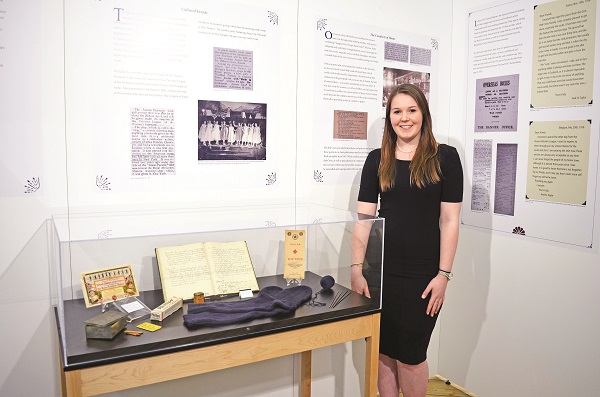|
This page was exported from The Auroran
[ http://www.newspapers-online.com/auroran ] Export date: Sat Apr 20 15:50:34 2024 / +0000 GMT |
Women’s Groups in focus as Aurora celebrates Temple of Fame centenary By Brock Weir Groups like 100 Women Who Care have shown how the power of women can make a difference on the community around them. These women's groups have been on something of an upswing in recent years, but before a downturn in the 1960s and 1970s, such groups were often the lifeblood of communities nation-wide. The impacts of Aurora's early women's groups, some that have gone largely forgotten over the past half-century, are very much in focus in The Temple of Fame: Staging Women's Roles, a new exhibition launched by the Aurora Museum and Archives to coincide with this weekend's production of The Temple of Fame. Guest-curated by Kara Isozaki, Maeghan Jerry and Sarah Kelly, combined Master of Information/Master of Museum Studies students from the University of Toronto, the exhibition takes a three-pronged approach to The Temple of Fame: the production itself and the local women who made it happen, the turning tide for women around the globe at the end of the First World War, and the groups who kept the home fires burning at that trying time in our collective history. Ms. Kelly focused on the role of women's groups, including the local Women's Institute and the Temperance Movement. “What I really liked were the stories of women,” says Ms. Kelly on her starting point. “There was the idea that there are these separate groups in Aurora doing different things with different pursuits in mind. When the war broke out, they didn't drop everything, but they changed the way they looked at things and melded together to really raise funds for the war, to help people in society who were affected by the war, to keep in contact with the soldiers overseas. You could see them coming together. In a lot of my research, I saw the expanding sense of neighbours; it was not just your neighbour next door, but maybe the neighbour you haven't even met.” At the very beginning, she tasked herself with sorting out which group of women did what – including their activities and their ultimate mandate. That, she said, was initially a frustrating challenge because there were no real boundaries or borders on the type of work each group did. There was plenty of overlap, “a melding” but, at the end of the day, each group “buckled up their bootstraps and got to work.” “I took a real liking to the way care packages were sent and received,” says Ms. Kelly on telling the human story. “The Aurora Banner had a really interesting set of letters they would print in their newspaper and those letters were cool because you could go back weeks before and see listings of women's groups calling other groups to come out into the community and put these boxes together, and you could see the response to these letters. “I knitted a pair of reproduction socks they would have sent over, which was really fun and interesting for me to do. One thing that really touched me was these women, even children, would knit these socks and write letters, and put them in the toe of the socks and send them over. You can even see letters coming back where soldiers would say, ‘I loved getting your care package, but missed getting the letter.'” This is an area of history that has always interested Ms. Kelly. She touched upon it in her undergraduate work, delving into the rural origin of women's groups as ways women learned collectively how to protect their families through safety and hygiene. “I think [that origin] is hard to make connections to,” she says. “Local women's groups disbanded in the 60s and 70s, but there have been recent trends of it coming together. I think it would be really cool to re-think what women's groups are today and what women can garner from each other and that service. I was a Girl Guide, I was a Ranger, and I have done a lot of volunteer work. It is kind of like Girl Guides to me. I like this idea of really pulling a group together through things like this and the things we feel are important to the community. “1918 was a really complicated time. Conflict was happening, you're losing loved ones, they are going overseas, and you have this group of women in a local context who just decide they are going to do things. They have priorities they want done, they want the vote, they want safe treatment for children, they want to do something about it, and all the time they have to keep in mind the war was happening and it was their part to step up and do something.” The Temple of Fame: Staging Women's Roles runs through June 10 at the Aurora Museum and Archives. The Museum is located on the second floor of the Church Street School. |
| Excerpt: Groups like 100 Women Who Care have shown how the power of women can make a difference on the community around them. These women’s groups have been on something of an upswing in recent years, but before a downturn in the 1960s and 1970s, such groups were often the lifeblood of communities nation-wide. |
|
Post date: 2018-05-10 10:28:58 Post date GMT: 2018-05-10 14:28:58 Post modified date: 2018-05-10 10:28:58 Post modified date GMT: 2018-05-10 14:28:58 |
| Powered by [ Universal Post Manager ] plugin. HTML saving format developed by gVectors Team www.gVectors.com |